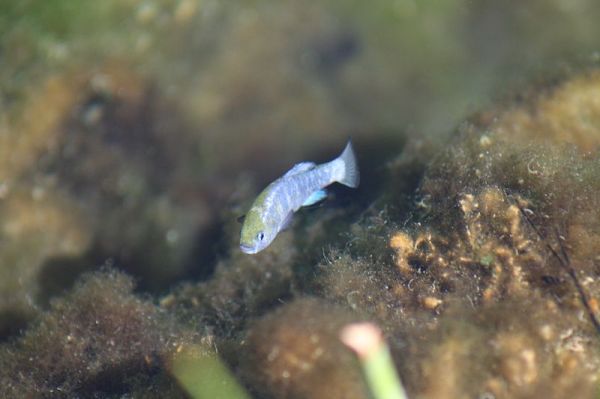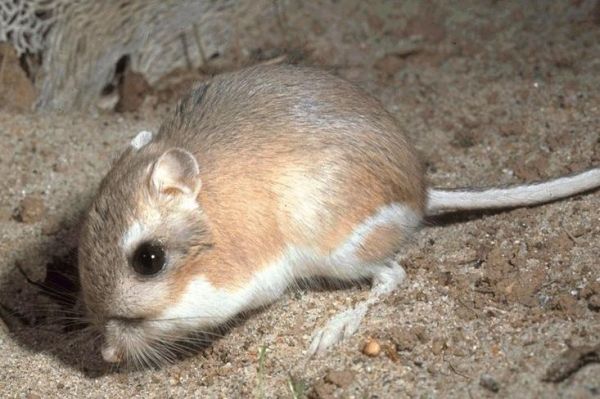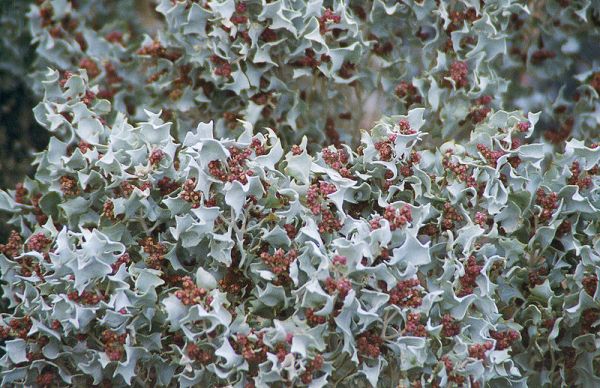1. The Rat with a Drinking Problem
Like
many Death Valley residents, the kangaroo rat lives for the nightlife.
It spends most of its day napping underground, only venturing out
after sunset. Of course, taking advantage of the cool nighttime temps
is a common trick among desert mammals. What’s not common is how the
kangaroo rat has adapted to deal with the scarcity of water: It never
drinks the stuff! Special organs inside its nose allow it to absorb
moisture directly from the air, and highly efficient kidneys keep its
body hydrated. In fact, the kangaroo rat is so well adapted to the dry
climate that even after living in captivity for years, it will still
refuse water.
2. The Fish That Got Lucky in Las Vegas
 Despite
its bone-dry landscape, Death Valley is home to thousands of pupfish.
The colorful, sardine-like fish live in isolated waterholes only a few
feet wide. But how did all those aquatic animals get lured into the
desert? The pupfish are actually stragglers from the ice age 10,000
years ago, back when the valley was a large glacial lake. As the
glaciers melted, schools of pupfish became trapped in the waterholes and
evolved into several distinct species. Today, the water in the small
ponds can be as warm as a bath (around 90 degrees F), and the salt
concentrations can exceed twice that of seawater. The conditions aren’t
ideal, but the pupfish survive by drinking copious amounts of water and
efficiently excreting the salt through their digestive tracts.
Despite
its bone-dry landscape, Death Valley is home to thousands of pupfish.
The colorful, sardine-like fish live in isolated waterholes only a few
feet wide. But how did all those aquatic animals get lured into the
desert? The pupfish are actually stragglers from the ice age 10,000
years ago, back when the valley was a large glacial lake. As the
glaciers melted, schools of pupfish became trapped in the waterholes and
evolved into several distinct species. Today, the water in the small
ponds can be as warm as a bath (around 90 degrees F), and the salt
concentrations can exceed twice that of seawater. The conditions aren’t
ideal, but the pupfish survive by drinking copious amounts of water and
efficiently excreting the salt through their digestive tracts.
Life for the pupfish has become even more difficult in recent years. Beginning in the 1960s, farmers near Death Valley started pumping the desert’s groundwater for irrigation, which depleted the waterholes and caused serious declines in pupfish populations. One particular species, the Devils Hole pupfish, came close to extinction in 2006 when its numbers dipped below 40. But then an unlikely savior emerged: the Mandalay Bay Hotel and Casino in Las Vegas. The casino relocated several pupfish to its swank aquariums, successfully reviving the species before its luck dried out.
3. The Plant That Outshines the Sun
It’s no secret that Death Valley is a tricky place for plants to take root. The earth there is so salty that it would kill most vegetation. But the Desert Holly has developed a clever technique for dealing with the unfriendly soil. The low-growing shrub soaks up the salt in the ground along with any moisture, and then, during blooming season from January to April, it excretes the sodium deposits onto its leaves. As a result, the plant turns from green to silver—a color change that helps it reflect the scalding sunlight instead of absorbing it.
4. The Bird You Don’t Want Your Children to See
 The
turkey vulture primarily feasts on decomposing animals, but that’s not
the most disgusting thing about it. To stay cool, the vulture makes
use of a process known asurohydrosis, a fancy way of saying that it
pees on its legs to keep from overheating. This serves two purposes:
the evaporating urine cools the blood circulating through the vulture’s
legs, and also acts as a disinfectant, killing any germs the scavenger
may have picked up from its last meal. You know you’re a dirty animal
when peeing on your own legs actually makes you cleaner.
The
turkey vulture primarily feasts on decomposing animals, but that’s not
the most disgusting thing about it. To stay cool, the vulture makes
use of a process known asurohydrosis, a fancy way of saying that it
pees on its legs to keep from overheating. This serves two purposes:
the evaporating urine cools the blood circulating through the vulture’s
legs, and also acts as a disinfectant, killing any germs the scavenger
may have picked up from its last meal. You know you’re a dirty animal
when peeing on your own legs actually makes you cleaner.
7. Seeds of Greatness
Every so often, Death Valley reveals a rare and beautiful display of life—a sea of colorful wildflowers, blossoming by the millions. The flowers seem to emerge out of nowhere, but in truth, the seeds of these blooms are always hidden on the desert floor, just waiting for the right amount of sunlight and rainfall before sprouting. The seeds are protected by a thick, waxy coating that guards them against the extreme heat. But when the desert gets enough rain to wash away the coating (which isn’t often), the seeds sprout and the flowers bloom, temporarily transforming the barren landscape.
8. The Flower That Haunts
The Gravel Ghost wildflower lives its life with the utmost discretion. It starts off as a patch of grayish leaves that blends in with the surrounding landscape. Then it sprouts a wiry stalk about 3 ft. high, which is also camouflaged against the barren scenery. But when the bulb atop the stalk blooms, it produces a vibrant white flower that insects flock to pollinate. Still, the stalk is so difficult to see that it creates the eerie appearance of a floating flower—hovering, ghost-like, above the desert floor.
9. Winning, by a Hare
The black-tailed jackrabbit may get teased for its oversize ears, but those trademark appendages help it beat the heat in Death Valley. The rabbit’s 7-inch-long ears contain a wealth of blood vessels that dissipate heat and help the animal regulate its body temperature. But the jackrabbit’s voracious appetite also plays into its success against the harsh climate. Like many desert creatures, the jackrabbit gets its water from the plants it eats. The clever hare switches its grazing seasonally, waiting until the hot summer months to consume the more water-filled cacti and grasses, often eating several times its body weight every day just to remain hydrated.
10. The Lizard That Was Born to Run
 Like
a water bug racing across a pond, the fringe-toed lizard glides with
gravity-defying grace over the loose sand of the desert. Specially
shaped scales on its toes allow the small reptile to scamper across the
dunes and outrun most predators. But speed isn’t the lizard’s only
superpower; the lightning-fast reptile can also vanish in an instant by
diving headfirst beneath the surface of the sand. Thanks to special
scales that fold over its eyes, ears, and nostrils, the fringe-toed
lizard can keep sand out of its delicate parts while steering clear of
predators underground.
Like
a water bug racing across a pond, the fringe-toed lizard glides with
gravity-defying grace over the loose sand of the desert. Specially
shaped scales on its toes allow the small reptile to scamper across the
dunes and outrun most predators. But speed isn’t the lizard’s only
superpower; the lightning-fast reptile can also vanish in an instant by
diving headfirst beneath the surface of the sand. Thanks to special
scales that fold over its eyes, ears, and nostrils, the fringe-toed
lizard can keep sand out of its delicate parts while steering clear of
predators underground.
2. The Fish That Got Lucky in Las Vegas
 Despite
its bone-dry landscape, Death Valley is home to thousands of pupfish.
The colorful, sardine-like fish live in isolated waterholes only a few
feet wide. But how did all those aquatic animals get lured into the
desert? The pupfish are actually stragglers from the ice age 10,000
years ago, back when the valley was a large glacial lake. As the
glaciers melted, schools of pupfish became trapped in the waterholes and
evolved into several distinct species. Today, the water in the small
ponds can be as warm as a bath (around 90 degrees F), and the salt
concentrations can exceed twice that of seawater. The conditions aren’t
ideal, but the pupfish survive by drinking copious amounts of water and
efficiently excreting the salt through their digestive tracts.
Despite
its bone-dry landscape, Death Valley is home to thousands of pupfish.
The colorful, sardine-like fish live in isolated waterholes only a few
feet wide. But how did all those aquatic animals get lured into the
desert? The pupfish are actually stragglers from the ice age 10,000
years ago, back when the valley was a large glacial lake. As the
glaciers melted, schools of pupfish became trapped in the waterholes and
evolved into several distinct species. Today, the water in the small
ponds can be as warm as a bath (around 90 degrees F), and the salt
concentrations can exceed twice that of seawater. The conditions aren’t
ideal, but the pupfish survive by drinking copious amounts of water and
efficiently excreting the salt through their digestive tracts.Life for the pupfish has become even more difficult in recent years. Beginning in the 1960s, farmers near Death Valley started pumping the desert’s groundwater for irrigation, which depleted the waterholes and caused serious declines in pupfish populations. One particular species, the Devils Hole pupfish, came close to extinction in 2006 when its numbers dipped below 40. But then an unlikely savior emerged: the Mandalay Bay Hotel and Casino in Las Vegas. The casino relocated several pupfish to its swank aquariums, successfully reviving the species before its luck dried out.
3. The Plant That Outshines the Sun
It’s no secret that Death Valley is a tricky place for plants to take root. The earth there is so salty that it would kill most vegetation. But the Desert Holly has developed a clever technique for dealing with the unfriendly soil. The low-growing shrub soaks up the salt in the ground along with any moisture, and then, during blooming season from January to April, it excretes the sodium deposits onto its leaves. As a result, the plant turns from green to silver—a color change that helps it reflect the scalding sunlight instead of absorbing it.
4. The Bird You Don’t Want Your Children to See
7. Seeds of Greatness
Every so often, Death Valley reveals a rare and beautiful display of life—a sea of colorful wildflowers, blossoming by the millions. The flowers seem to emerge out of nowhere, but in truth, the seeds of these blooms are always hidden on the desert floor, just waiting for the right amount of sunlight and rainfall before sprouting. The seeds are protected by a thick, waxy coating that guards them against the extreme heat. But when the desert gets enough rain to wash away the coating (which isn’t often), the seeds sprout and the flowers bloom, temporarily transforming the barren landscape.
8. The Flower That Haunts
The Gravel Ghost wildflower lives its life with the utmost discretion. It starts off as a patch of grayish leaves that blends in with the surrounding landscape. Then it sprouts a wiry stalk about 3 ft. high, which is also camouflaged against the barren scenery. But when the bulb atop the stalk blooms, it produces a vibrant white flower that insects flock to pollinate. Still, the stalk is so difficult to see that it creates the eerie appearance of a floating flower—hovering, ghost-like, above the desert floor.
9. Winning, by a Hare
The black-tailed jackrabbit may get teased for its oversize ears, but those trademark appendages help it beat the heat in Death Valley. The rabbit’s 7-inch-long ears contain a wealth of blood vessels that dissipate heat and help the animal regulate its body temperature. But the jackrabbit’s voracious appetite also plays into its success against the harsh climate. Like many desert creatures, the jackrabbit gets its water from the plants it eats. The clever hare switches its grazing seasonally, waiting until the hot summer months to consume the more water-filled cacti and grasses, often eating several times its body weight every day just to remain hydrated.
10. The Lizard That Was Born to Run



No comments:
Post a Comment